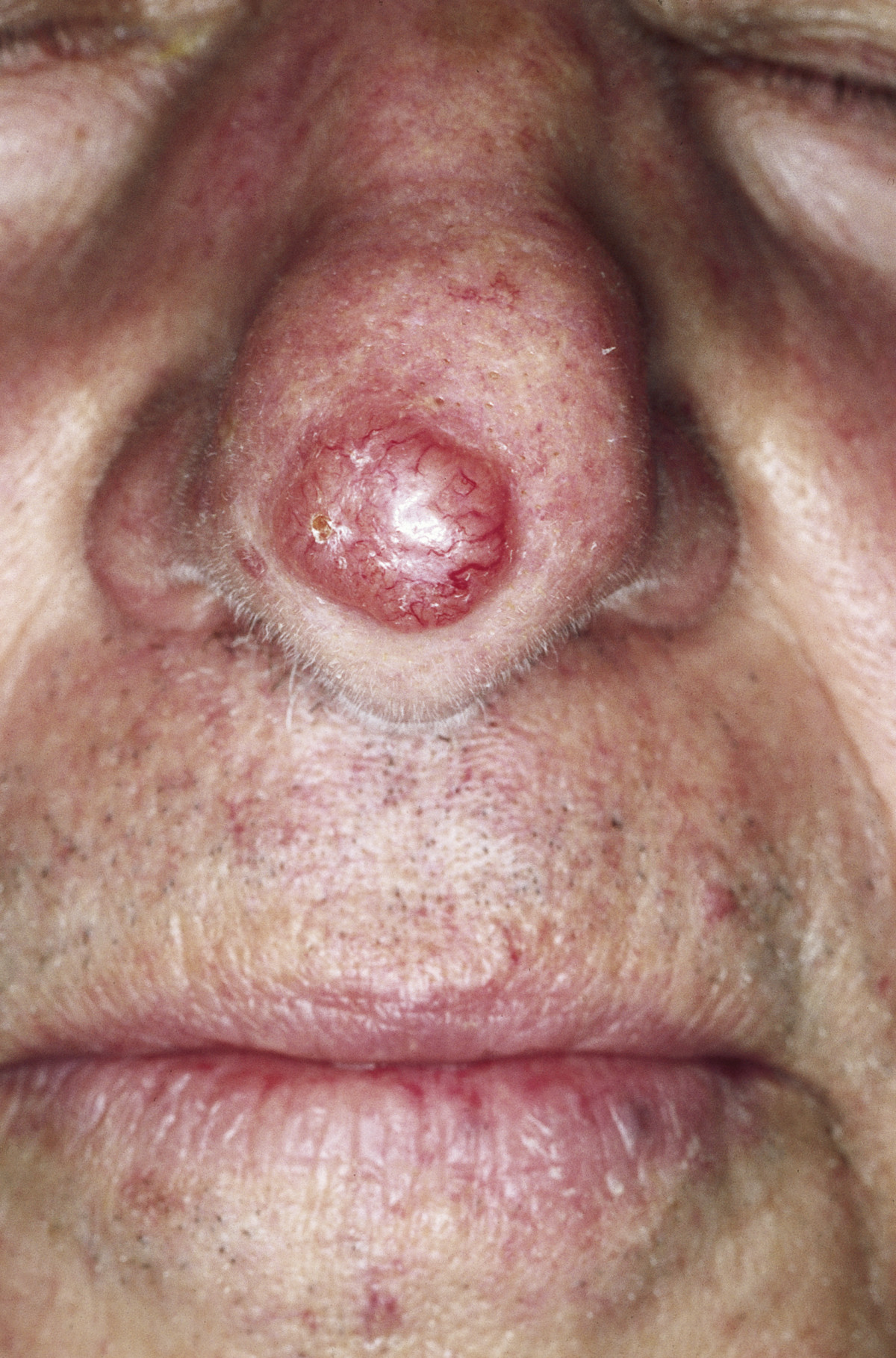Playlist
Show Playlist
Hide Playlist
Basal Cell Carcinoma: Pathophysiology
-
Reference List Pathology.pdf
-
Slides Basal Cell Carcinoma Pathophysiology.pdf
-
Download Lecture Overview
00:01 Welcome. 00:02 With this talk, we're going to delve into the world of malignant epithelial tumors. 00:08 This one is on basal cell carcinoma, but others will explore squamous cell carcinoma and melanoma. 00:15 So basal cell carcinomas are skin cancers arising from the basal layer of epidermis, hence the name. 00:21 And they have a very characteristic look on histology. 00:25 By the end of this talk, you'll be able to make the diagnosis because of how characteristically they look. 00:31 So the epidemiology of this, far and away, this is one, the most common skin malignancy, but also the most common cancer worldwide. 00:41 It wins out over all the others hands down. 00:45 The US incidence of the disease is 200 to 250 per 100,000 person years. 00:51 It is exceptionally common. 00:53 More frequently seen in men than in women, that may be in fact because men spend more time in the sun, maybe, and or don't apply sunscreen and or makeup to the same extent that women do. 01:06 There's not a significant risk associated, say, with testosterone exposure. 01:13 The incidence increases with age, so I think it's lifetime exposure to ultraviolet light, and truly this is driven by the sun and UV exposure. 01:21 However, there are genetic syndromes, and we will cover one of those, specifically, Gorlin syndrome in a moment. 01:29 The pathophysiology of this, okay, I've already said it's the sun, and it is the sun. 01:35 Ultraviolet exposure, UVA and UVB leads to DNA double-stranded breaks. 01:42 And those breaks, when they accumulate in the basal cells, will eventually lead to a malignancy. 01:51 So sun exposure with outdoor workers, sun worshippers, tanning beds, phototherapy for psoriasis can also drive this. 01:59 Other risk factors include advancing age, I think, again, lifetime exposure to ultraviolet light. 02:05 Interestingly, arsenicals increases that. 02:07 That's because arsenic actually acts in concert with ultraviolet light to induce mutagenesis. 02:14 Any other form of ionizing radiation, so if you are getting irradiated for, say, a tumor that is deeper, the skin in that area may actually be at greater risk for developing basal cell carcinoma. 02:31 If you don't have a good immune system that can surveil and then destroy, through immunologic means, basal cell carcinomas, then you are at greater risk. 02:41 And then there are the genetic bases, and we'll get into that a little bit more now. 02:46 So the genetic syndromes, key amongst these is Gorlin syndrome. 02:51 I've already mentioned it. 02:53 And we'll talk specifically about which gene is involved. 02:56 It's the patch gene, so keep that in mind as we go forward. 03:01 It has not only the risk of multiple basal cell carcinomas, but other developmental anomalies. 03:07 And you'll see the patch plays a major role in regulating cell proliferation. 03:12 Other genetic syndromes that are associated with basal cell carcinoma, as you might expect, zero dermapigmentosum. 03:19 So that is any of a variety of mutations in up to nine different genes involved in UV-induced DNA damage repair. 03:29 So if you don't have good repair of the DNA, you're more likely to get basal cells. 03:34 There is a disease, Bayezex, Dupre-Cristol syndrome, and that leads to a variety of other hyperproliferation of adnexal structures in the skin, but also multiple basal cell carcinomas. 03:50 And then, as you might expect, oculocutaneous albinism, where you don't make melanin, you're not protected. 03:57 So melanin is protected against UV damage by absorbing that energy and converting it basically into heat. 04:04 If you don't have melanin, you're an albino, then you're at much greater risk of developing basal cell carcinomas. 04:12 So let's talk about patch, and it's not PATCH, but patch, PTCH1 is a gene that is found in the majority of even sporadic basal cell carcinomas. 04:27 It encodes a protein in the hedgehog pathway. 04:31 Okay, what's that? So let's see a schematic here of how patch works. 04:37 So in cells that are non-proliferating, that are inactive, patch, a protein sits on the surface, interacts with a molecule, another protein on the surface called smoothen. 04:50 And when it interacts with it, it turns off smoothen. 04:54 Okay, that's fine, and that keeps the cell non-proliferative. 04:59 However, if we want the cell to grow, we want it to divide and have more cells, then we can add a variety of factors that interact and turn on the patch pathway. 05:13 So you see that ball that's attached to patch. 05:16 Now, patch is no longer going to inhibit smoothen. 05:20 Smoothen is then able to act on a variety of proteins that are in the cytoplasm that are going to be transcription factors. 05:29 And in particular, when smoothen is doing its thing, it is releasing GLI, which is a glioma-associated gene product, a transcription factor that can then go into the nucleus and drive a variety of proliferative pathways. 05:47 It turns on genes that are going to drive cellular growth and proliferation. 05:52 So that's how it works when we want a cell to be turned on and proliferate. 05:58 What happens if patch is mutated or we've lost one of the patch genes and we aren't making very much patch protein? Well, that means smoothen is doing its thing all the time and it's releasing GLI all the time and the cells are turned on to proliferate all the time so you have uncontrolled cellular proliferation. 06:19 That's one thing, you can get increased growth. 06:21 But then if you acquire additional mutations that cause genetic instability beyond just that proliferation, then you get cancer. 06:32 TP53 mutations are also seen in a significant percentage of sporadic basal cell carcinomas. 06:39 Recall that TP53 is a gene that generates a protein that is involved in recognizing DNA damage, that's what it does. 06:48 And then it also sets into motion the various mechanisms that are going to repair that DNA damage. 06:54 If we acquire mutations or have germline mutations in TP53, that would be the Lee-Fraumeni syndrome. 07:03 If we have those mutations, then we don't have the normal recognition of DNA damage, which is going on all the time from UV or endogenous sources such as oxygen free radicals. 07:15 And then we will have an increased incidence of developing the various features that will lead us on our way to malignancy. 07:22 So increased cell proliferation, DNA defective repair.
About the Lecture
The lecture Basal Cell Carcinoma: Pathophysiology by Richard Mitchell, MD, PhD is from the course Premalignant and Malignant Epidermal and Dermal Tumors.
Included Quiz Questions
What is the approximate incidence of basal cell carcinoma in the United States per 100,000 person-years?
- 200-250
- 50-100
- 500-550
- 1000-1200
- 10-20
How does normal PTCH1 protein regulate cell proliferation in the Hedgehog pathway?
- It inhibits smoothened protein activity
- It directly stimulates DNA repair
- It activates smoothened protein
- It blocks melanin production
- It promotes UV radiation resistance
Which genetic syndrome is associated with multiple basal cell carcinomas and involves mutations in genes responsible for UV-induced DNA damage repair?
- Xeroderma pigmentosum
- Marfan syndrome
- Down syndrome
- Turner syndrome
- Klinefelter syndrome
What is the primary consequence of losing functional PTCH1 protein in basal cell carcinoma development?
- Continuous activation of smoothened protein leading to uncontrolled cell proliferation
- Complete cell cycle arrest preventing normal epidermal cell differentiation
- Increased melanin production causing hyperpigmentation of affected tissues
- Decreased UV light absorption resulting in DNA photodamage accumulation
- Enhanced DNA repair mechanisms promoting cellular immortalization
Customer reviews
5,0 of 5 stars
| 5 Stars |
|
5 |
| 4 Stars |
|
0 |
| 3 Stars |
|
0 |
| 2 Stars |
|
0 |
| 1 Star |
|
0 |




